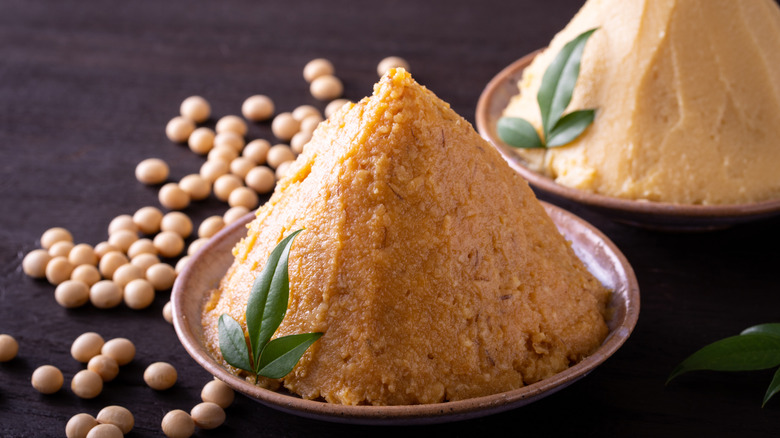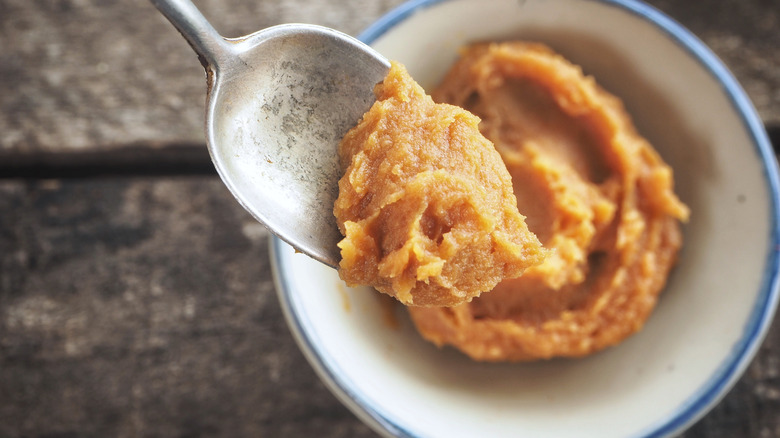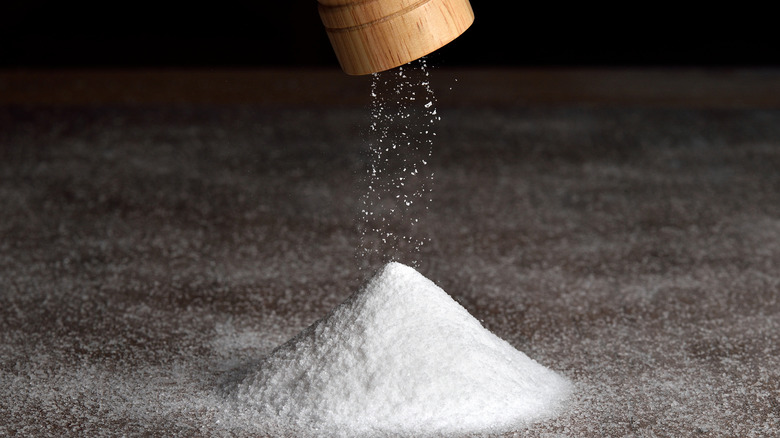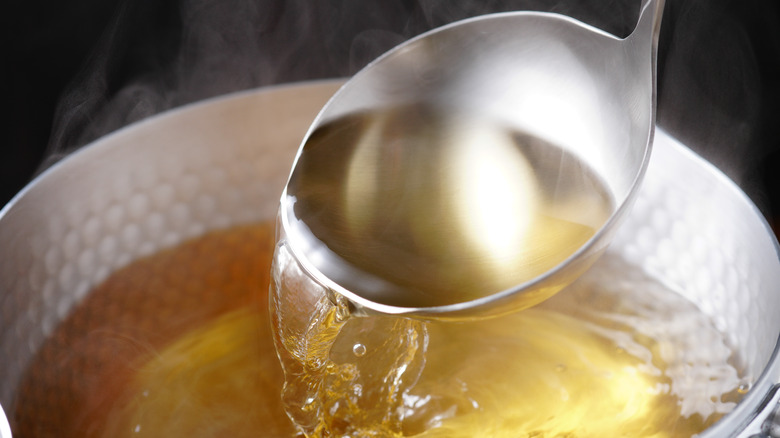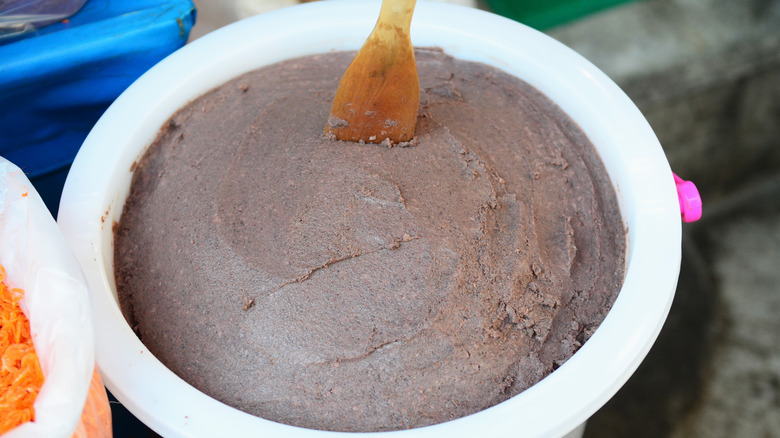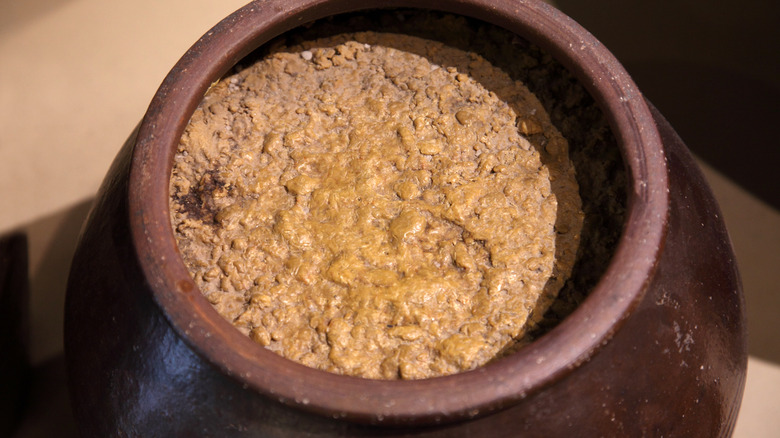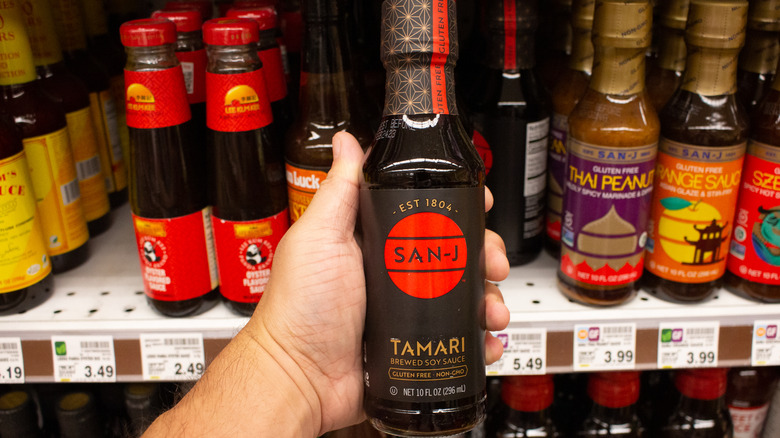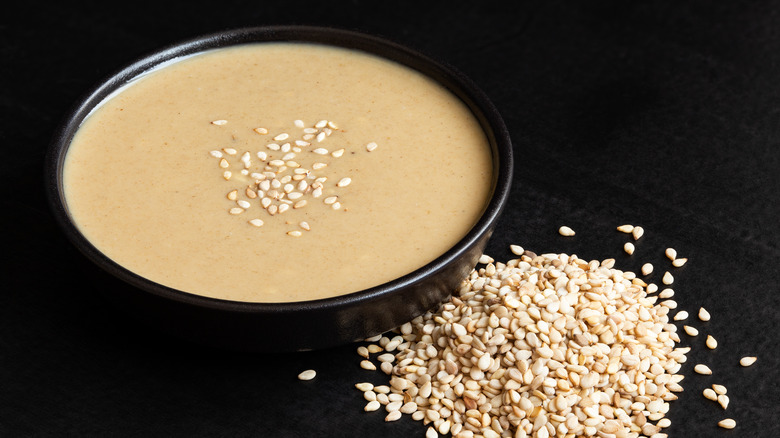10 Best Substitutes For Miso Paste
When it comes to ingredients that pack a serious burst of flavor, miso paste is definitely at the top of the list. Though most people are familiar with the ingredient when it comes in the form of a simple miso soup, usually served prior to a Japanese feast, there are so many more uses for the paste that has so much of that sought-after umami flavor.
However, the reality is not every grocery store will have miso paste on the shelves. Though it's obviously incredibly common at Asian markets or grocery stores with a larger international food selection, you may not be able to find it on the shelves of your regular grocery store. So, what's a home cook to do when faced with a recipe that calls for miso paste, but you can't quite get your hands on the ingredient? You can certainly search online, but in the interim, there are several great substitutes you can try out when whipping up your culinary creation. As with any substitution, you'll want to consider exactly what the purpose of the miso paste is in the recipe, and what you're trying to replicate beyond the mere flavor in order to make the most ideal substitution.
Whether you're adding miso paste to a steaming bowl of soup or using it as a glaze or marinade for your protein of choice, there's no denying that it's an absolute superstar. If you're looking for a substitution, though, here are 10 great options to consider.
1. DIY Miso Paste
Don't worry, you won't have to ferment your own soybeans in a pinch when you need miso paste in a recipe — instead, there are some options to combine a variety of ingredients in order to mimic the various qualities and flavor notes in miso. A substitute recipe from Gourmet Sleuth uses a surprising ingredient as the base, presumably in order to mimic the paste-like consistency and creamy notes within miso paste: refried beans. The beans can be combined in a blender with two tablespoons of honey to add a bit of sweetness, as well as 1.5 tablespoons of Marmite or Vegemite yeast to infuse that umami flavor and a hint of salt, plus a tablespoon of beer to mimic some of those subtle fermented flavor notes.
Then, simply blend all the ingredients at a high speed until it's a silky smooth paste, and store in the refrigerator. This substitute would likely work well in dishes where you need to try to mimic multiple components of the miso paste, from the flavor to the consistency. For the best results, you could do a direct substitution, using one tablespoon of your DIY concoction in place of every tablespoon of miso paste called for in the recipe.
2. Salt
When you're thinking of recipe substitutions for miso paste, chances are that simple salt is probably not the first thing that comes to mind. After all, while it's an absolutely essential seasoning in just about every recipe, it doesn't exactly impart any particular flavors beyond, well, saltiness. However, depending on how much miso paste your recipe calls for, it could be that you really just need something to enhance the overall flavor profile of your dish, and salt might be just the key (via Substitute Cooking).
Salt won't be able to add any extra flavors to your dish, so this substitute is better used in recipes that call for only small amounts of miso paste, where miso isn't one of the primary flavors. The one benefit is that it's an ingredient that virtually every cook has in their kitchen, and if it's not already on hand, it's on the shelves just about everywhere. Adding a simple dash of salt can enhance a lot of the flavors in your dish, and simply swapping out a small amount of miso paste with some salt could be all you need to create the bold taste you're going after.
The main thing to consider with this substitution is the amount you're using — it's far easier to add a bit more salt to taste than to deal with a dish that has been over-seasoned to the point where it's inedible. If your recipe calls for a teaspoon of miso paste, start out with half a teaspoon of salt, taste, and then adjust as you feel is needed.
3. Dashi
Dashi is a flavorful broth crafted from water, dried kelp, and bonito fish flakes that is used to add flavor to many dishes (via The Home Of Cuisine). It has a deep complexity of flavor with a hint of salt and fishiness, but is nowhere near as powerful and intense as potential substitutes like soy sauce and tamari, making it quite a versatile substitution for miso.
In terms of dietary restrictions, though the semi-clear broth may fool you into thinking it's crafted with just plant-based ingredients, the presence of fish flakes does mean that this substitute won't work if you're making a vegetarian dish. Another important thing to consider is the consistency — while miso paste is thick, dashi is a thin, watery broth, making this a good substitute for dishes where the liquid content doesn't matter as much.
Even so, if you're using larger amounts, you'll want to dial back the other liquids in your dish to ensure you don't get a soupy mess. The relatively mild flavor of this substitute means you can use it in a direct swap — so, if your recipe calls for a quarter-cup of miso paste, you could use a quarter-cup of dashi instead.
4. Anchovy Paste
While miso paste is crafted from fermented soybeans and not fish, there are a lot of the same umami flavors found in miso paste that anchovy paste can help mimic, says I Am Going Vegan. In fact, miso paste is commonly suggested as a vegan alternative to anchovy paste in recipes, which means this substitution works just as well in the opposite manner.
Anchovy paste has a similar overall consistency to miso paste, which makes it easy to substitute in all types of recipes. The one thing to note is that anchovy paste is a bit more oily than miso paste, so when using this substitution, you may want to be mindful of the overall oil content of your recipe and potentially dial it back. This also is, obviously, not the ideal substitute if you're serving plant-based diners who don't eat fish, as you're swapping out the plant-based miso paste with a fish-based alternative.
For the best results, you can use the same amount of anchovy paste as you would have used miso paste — so, add a teaspoon of the fishy ingredient if your recipe calls for a teaspoon of miso. This swap is also particularly well-suited to recipes that specifically call for white miso paste, as it's the most similar in overall flavor profile.
5. Soybean Paste/Doenjang
Given that miso paste is made from a process that involves fermenting soybeans, it makes sense that a solid substitute would involve the same ingredients, but that are just processed in a slightly different manner. Soybean paste is a relatively common ingredient in Korean cuisine, where you will likely see it listed on packaging as Doenjang (per Richard's Pantry). This substitution mimics the consistency of miso paste, as it is likewise in a thick format. It also has a depth of flavor that can add some serious complexity to many different types of dishes, whether you're using it for a marinade or in a dressing of some kind.
There are just two things to consider with this swap. First of all, this ingredient is less commonly found than some other substitution options, so unless you have a very well-stocked pantry or a grocery store with an extensive Korean section, you may not have an easy time tracking soybean paste down. Additionally, it packs a lot more salt than miso paste, so you'll want to ensure you don't overpower your dish. For best results, start with about half the amount, meaning you'd use a half-tablespoon of soybean paste if your recipe calls for a tablespoon of miso paste.
6.Vegetable Broth or Stock
Vegetable broth or stock is an incredibly common ingredient that many people likely have available in their pantry at all times, or at the very least, can easily find at their local grocery store. Broths and stocks can be absolutely fantastic at adding some extra flavor to recipes, and vegetable broth or stock in particular can make a decent substitute for miso paste (via Fitibility).
It doesn't quite have the same flavor profile, so it's not the best substitute for recipes in which the miso paste is one of the dominant flavor notes. However, if the miso paste is simply used sparingly to enhance the flavors of the dish and add a bit of complexity, vegetable broth just might work.
The two important things to consider with this substitution are consistency and salt content. Since it's a broth and not a paste, it's best suited to recipes like soups and dressings where having a bit of extra liquid won't make too much of an impact. Additionally, you'll want to read the label to find out whether your vegetable broth has salt added or not — if so, you may need to dial back on the salt you add to season your dish. For best results, you can do a direct substitute with this ingredient, using a tablespoon of vegetable broth or stock for the tablespoon of miso paste called for in your recipe.
7. Fish Sauce
If you love to cook Asian cuisine, you just may have a bottle of fish sauce amongst your condiments, perfect for adding that delectable depth of flavor to sauces and stir fries. Luckily, it also makes a pretty good substitute for miso paste, says Organically Blissful. In terms of flavor, fish sauce actually has quite a few similarities in overall profile to soy sauce and tamari, helping to imbue that umami flavor into your dish. Plus, since it's crafted from fermented fish, it has some similarities to fermented miso paste in that regard as well.
The one major benefit for this particular ingredient is how allergen-friendly it is — namely, it has no gluten and no soy, which makes it perfect for anyone with those particular dietary restrictions. There's a reason fish sauce used in so many Asian dishes as a little goes a long way, and it packs some serious flavor. However, for best results, since it does have a fairly intense profile, you'll want to be a bit light-handed in your substitution to start — so, if your recipe calls for a tablespoon of miso paste, a mere half-teaspoon of fish sauce should be enough to enhance your dish.
8. Tamari
Like soy sauce, tamari is a byproduct of fermenting soybeans, so it has a lot of similarities to miso paste in terms of overall flavor profile, according to Spiceography. It packs in those umami flavors that you want in your dish and also introduces a flavor-enhancing dash of saltiness into whatever you're whipping up. One plus with this substitute is that it doesn't have quite as much salt as regular soy sauce, which means you won't need to dial back on the other seasonings in your recipe quite as much.
As an added bonus, while it's nowhere near as thick as miso paste, tamari does have a bit of a thicker consistency. This means it can be an ideal substitute for recipes like marinades, where having something that's liquid rather than a paste can actually be helpful, but you don't want something so thin it just drips down whatever you're trying to season.
Finally, one thing to consider about this substitution is that tamari is nearly always gluten-free, making it a perfect selection if you're creating a dish for someone that is affected by gluten. Since the flavor of tamari is quite strong and it does pack a salty punch, you'll want to use about half the amount in this substitution: If your recipe requires a tablespoon of miso paste, you can use a half-tablespoon of tamari instead.
9. Tahini
If you're a fan of Mediterranean flavor profiles — or simply love to whip up homemade hummus — there's a good chance you may have a jar of tahini on hand. This sesame seed paste has a rich, creamy, complex flavor that makes it a fantastic addition to so many dishes. Tahini's unique blend of tastes means it often works to enhance the flavors of a dish, adding more depth and complexity, in a similar way to miso paste (via Richard's Pantry).
It can be a good substitute for miso paste when consistency is an important factor and you don't want to add a ton more liquid to a particular dish. However, there's one important thing to consider with this substitute: The flavor profile of miso paste and the flavor profile of tahini are really quite different. While the latter has a similar creaminess and complexity, it also has more nutty flavor notes.
So, this substitute is best in recipes that call for only a small amount of miso paste, in which case you can do a direct substitution, using a teaspoon of tahini in place of a teaspoon of miso paste. If the ingredient is needed in much larger quantities, you risk changing the overall flavor of your dish with this particular substitution and you might want to choose another pick on this list.
10. Soy Sauce
Given that miso paste is made from fermented soy beans, it makes sense that another soy-based product would be a solid substitute. Soy sauce packs a ton of that umami flavor, and also brings some saltiness to your dish. As an added bonus, it's a very accessible ingredient that you likely have in your fridge already, nestled amongst all your other condiments, or something you would find at just about every grocery store.
The one thing you'll need to consider with this particular substitute is the consistency. While miso paste is, well, a paste, soy sauce has a very liquid texture. This may not make a difference if you're only substituting a spoonful or two, but if you need a larger amount, you may need to slightly adjust the other proportions in your recipe. The difference in consistency means this swap is better for dishes like soups and stews, or even dressings and sauces, since the liquid nature of soy sauce won't make as much of a difference in those concoctions.
Since soy sauce has a bit more salt and a stronger flavor than miso paste, you'll want to halve the amount for best results. So, if your recipe calls for two tablespoons of miso paste, you would substitute one tablespoon of soy sauce.
